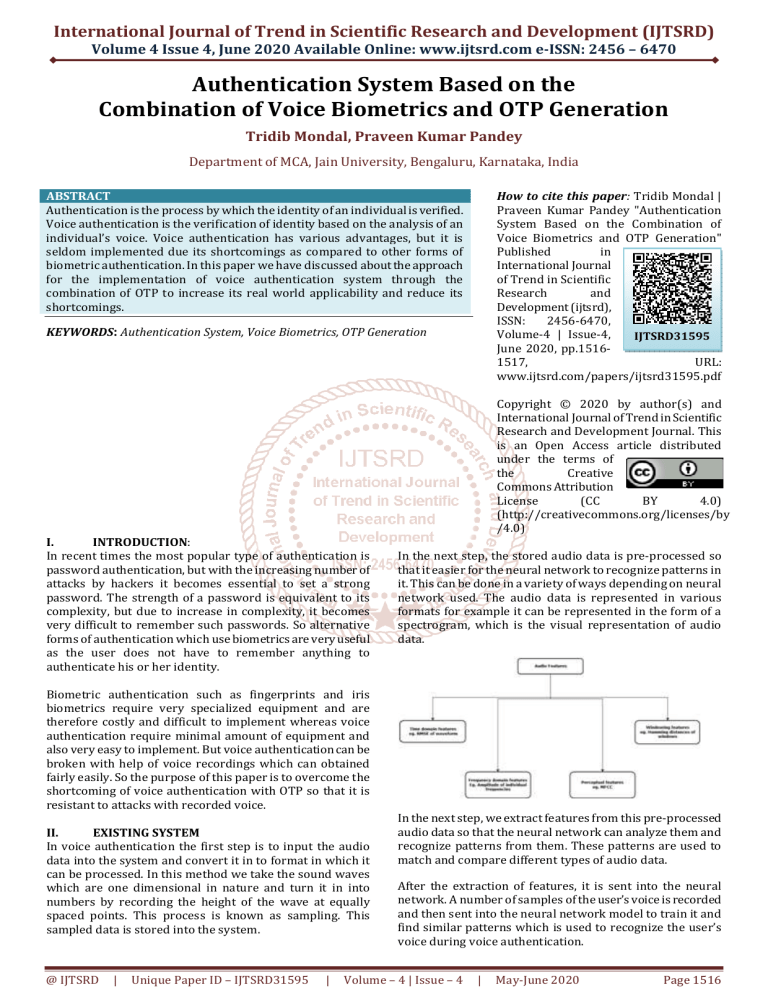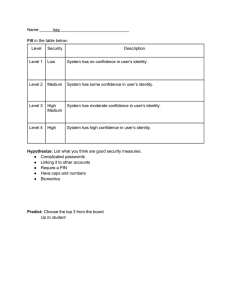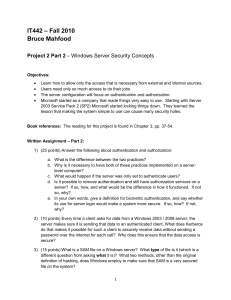
International Journal of Trend in Scientific Research and Development (IJTSRD)
Volume 4 Issue 4, June 2020 Available Online: www.ijtsrd.com e-ISSN: 2456 – 6470
Authentication System Based on the
Combination of Voice Biometrics and OTP Generation
Tridib Mondal, Praveen Kumar Pandey
Department of MCA, Jain University, Bengaluru, Karnataka, India
ABSTRACT
Authentication is the process by which the identity of an individual is verified.
Voice authentication is the verification of identity based on the analysis of an
individual’s voice. Voice authentication has various advantages, but it is
seldom implemented due its shortcomings as compared to other forms of
biometric authentication. In this paper we have discussed about the approach
for the implementation of voice authentication system through the
combination of OTP to increase its real world applicability and reduce its
shortcomings.
How to cite this paper: Tridib Mondal |
Praveen Kumar Pandey "Authentication
System Based on the Combination of
Voice Biometrics and OTP Generation"
Published
in
International Journal
of Trend in Scientific
Research
and
Development (ijtsrd),
ISSN:
2456-6470,
Volume-4 | Issue-4,
IJTSRD31595
June 2020, pp.15161517,
URL:
www.ijtsrd.com/papers/ijtsrd31595.pdf
KEYWORDS: Authentication System, Voice Biometrics, OTP Generation
Copyright © 2020 by author(s) and
International Journal of Trend in Scientific
Research and Development Journal. This
is an Open Access article distributed
under the terms of
the
Creative
Commons Attribution
License
(CC
BY
4.0)
(http://creativecommons.org/licenses/by
/4.0)
I.
INTRODUCTION:
In recent times the most popular type of authentication is
password authentication, but with the increasing number of
attacks by hackers it becomes essential to set a strong
password. The strength of a password is equivalent to its
complexity, but due to increase in complexity, it becomes
very difficult to remember such passwords. So alternative
forms of authentication which use biometrics are very useful
as the user does not have to remember anything to
authenticate his or her identity.
In the next step, the stored audio data is pre-processed so
that it easier for the neural network to recognize patterns in
it. This can be done in a variety of ways depending on neural
network used. The audio data is represented in various
formats for example it can be represented in the form of a
spectrogram, which is the visual representation of audio
data.
Biometric authentication such as fingerprints and iris
biometrics require very specialized equipment and are
therefore costly and difficult to implement whereas voice
authentication require minimal amount of equipment and
also very easy to implement. But voice authentication can be
broken with help of voice recordings which can obtained
fairly easily. So the purpose of this paper is to overcome the
shortcoming of voice authentication with OTP so that it is
resistant to attacks with recorded voice.
II.
EXISTING SYSTEM
In voice authentication the first step is to input the audio
data into the system and convert it in to format in which it
can be processed. In this method we take the sound waves
which are one dimensional in nature and turn it in into
numbers by recording the height of the wave at equally
spaced points. This process is known as sampling. This
sampled data is stored into the system.
@ IJTSRD
|
Unique Paper ID – IJTSRD31595
|
In the next step, we extract features from this pre-processed
audio data so that the neural network can analyze them and
recognize patterns from them. These patterns are used to
match and compare different types of audio data.
After the extraction of features, it is sent into the neural
network. A number of samples of the user’s voice is recorded
and then sent into the neural network model to train it and
find similar patterns which is used to recognize the user’s
voice during voice authentication.
Volume – 4 | Issue – 4
|
May-June 2020
Page 1516
International Journal of Trend in Scientific Research and Development (IJTSRD) @ www.ijtsrd.com eISSN: 2456-6470
Although this type of voice authentication has various
advantages the main drawback from the security point of
view is that it cannot differentiate between a recorded voice
played from an audio voice and the actual user. The system
only recognizes feature patterns from the audio, which is
also present in audio played through audio devices. This is a
huge problem for an authentication system, as the identity of
the user, can be easily spoofed with the help of a recording of
the user’s voice.
III.
SOLUTION
Considering the drawback mentioned above, a possible
solution is the implementation OTP along with voice
authentication. In this method, first during the registration
process the user is requested to recite numbers from zero to
nine, one by one a number of times. This data, is recorded as
ten different inputs and then sent into the algorithm, to train
it so that it can recognize the voice pattern of the user. After
This implementation is a very effective solution because the
attacker cannot access the system with a pre-recorded audio
as the voice passphrase changes every time. As each digit of
the passphrase, is converted into text and compared with the
generated OTP, a previously recorded audio of the user will
have the same voice pattern but after it has been converted
to text it will not match currently generated OTP, thereby
preventing identity spoofing.
IV.
REFERENCES
[1] Homayoon Beigi (2011), "Fundamentals of Speaker
Recognition", Springer-Verlag, Berlin, 2011, ISBN 9780-387-77591-3.
@ IJTSRD
|
Unique Paper ID – IJTSRD31595
|
the registration process is completed, the user can login
using his voice. In the login process, the user sends an
authentication request, after receiving this request the
program generates a random four digit unique code, which is
displayed on the screen. Then unique code or OTP is recited
by the user. When the OTP is recited by the user, it is taken
as input into the system. Each digit recited by the user is
input into the previously trained algorithm one by one, the
pattern of the voice is matched with the pattern of the user’s
voice. If the voice pattern of each of the digit matches with
the voice pattern of the user, the next step is initiated where
each digit is converted from speech to text format, this text is
the matched with the previously generated OTP. If the text
matches with the previously generated OTP, then the
authentication process is complete and the user is granted
access.
[2] "Biometrics from the movies" –National Institute of
Standards and Technology
[3] Elisabeth Zetterholm (2003), Voice Imitation. A
Phonetic Study of Perceptual Illusions and Acoustic
Success, Phd thesis, Lund University.
[4] Md Sahidullah (2015), Enhancement of Speaker
Recognition Performance Using Block Level, Relative and
Temporal Information of Subband Energies, PhD
thesis, Indian Institute of Technology Kharagpur.
Volume – 4 | Issue – 4
|
May-June 2020
Page 1517




